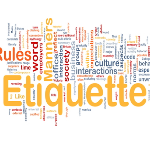 When you’re new to someone’s home, you conduct yourself in a respectable manner. If you see that people take their shoes off before going upstairs, you ask if you should take your shoes off (at least I do). You basically conduct yourself in a way that’s respectful of the other person’s space.
When you’re new to someone’s home, you conduct yourself in a respectable manner. If you see that people take their shoes off before going upstairs, you ask if you should take your shoes off (at least I do). You basically conduct yourself in a way that’s respectful of the other person’s space.
In social media, new users might do things that go against the norm of what’s considered “appropriate” behavior. You might get someone who spams Twitter will blatant self-promotional Tweets. Or someone who spams Facebook Walls with links to their own stuff. Sometimes, you try and give them the benefit of the doubt. After all, they’re new.
So today, I thought I’d publish an informal guide to the unspoken rules of online etiquette. Feel free to add your own take in the comments.
Appearance Matters
- Unless you’re a big name brand like Coca-Cola, people don’t like friending logos.
- Ditch the glamour shot from 10 years ago.
- Be mindful of what you publish (blogs, comments, Tweets, Status Updates, etc.) because once it’s out there, it’s out there.
- Venting about a client on Facebook probably isn’t a good idea especially if you’re friends with said client on Facebook.
- A well polished website design makes a difference. If your site is too difficult to navigate, you’re going to lose customers.
Friending Others
- Friending isn’t an obligation, it’s a privilege. Don’t get upset if someone doesn’t “Follow” you back or accepts your “Friend Request” on Facebook. It’s nothing personal (unless of course it is).
- It’s ok to follow the competition (you don’t have to, but it’s ok if you do).
- It’s ok to set different rules for different networks. For example, I’m more likely to follow (almost) anyone on Twitter, but I won’t accept your Friend Request on Facebook unless I personally know you and/or we’ve met before.
- Use lists whenever possible. You can create lists on Twitter, Facebook and use “Circles” on Google+. Use lists as a way to manage noise and follow who’s important to you.
Managing Conversations
- Don’t moderate comments. If you must, just make sure it doesn’t take you a week to approve them. There’s no quicker way to make reader’s feel neglected.
- Responsiveness counts. If I leave a comment, and you don’t respond, but you responded to everyone else’s comment, well, you just lost a reader and potentially a customer.
- Don’t take days to respond to an email inquiry. Especially if your contact form reads “we respond to emails within 24 hours.” You’ll lose business opportunities this way.
- You don’t have to reply to all social mentions, but do make an effort. It says you don’t care and you’ll quickly lose some of your best fans.
- You don’t need to RT every positive compliment someone gives you – that’s annoying. In some cases, it looks like you’re “trying to hard.” A simple “thank you” should suffice.
Sharing & Promoting
- Promote other people’s stuff 10x’s more than you promote your own. This does two things: 1.) it builds good karma and people will see you as a resource for finding good content, 2.) it shows that you’re not just there to blatantly self-promote and sell your own stuff.
- It’s ok to link to your recent blog post or event Tweet out a discount – you know, that self-promotion stuff. But as they say in the Tanqueray commercial’s, “always in moderation.”
- Just remember, the more you promote others, the more likely they are to promote you in return.
- If you like something someone wrote, Tweet it, “Like” it, Stumble it. It’s encouraging and it’s also an indirect of saying “hey, that was a really good post.”
- But don’t send me a DM every day asking me to Tweet, “Like,” and Stumble your latest blog post – especially if we’ve never met before.
Content Creation
- The more consistently you create, the better. That could mean once a week, twice a week or daily. Just as long as you stay consistent.
- Generally speaking, the more you publish, the more traffic you get (provided it’s good, relevant content).
- Use images and lists to break up your text and make it easier to read (remember: people love to skim through content).
- Don’t forget about your Call To Action and the end of each post. This could mean asking people to comment, subscribe or take action on something (a product) you have to offer.
- Don’t RT yourself once every hour. On the other hand, it’s ok to Tweet about your post 2-3 times a day to reach different time-zones.
- Don’t DM people you don’t know or have previous relationship with asking them to RT your blog post.
- Don’t spam other people’s comments saying things like: “Great post, I recently talked about this subject here ______________. You should read it and Tweet it!”
- Comment when you have something valuable to add to the discussion (this includes blogs, Facebook updates, and Google+.
- Don’t email everyone on a Facebook thread. Those are annoying. Instead, email folks individually. Or use your Fan page to communicate with folks in that manner.
- If you comment on a Facebook thread, the notifications will end sooner or later.
- I know your newsletter is awesome, but still, don’t assume I want to receive it and auto-subscribe me. By default, that ruins our relationship before it even starts.
- Once you build an email list, work hard on delivering the promise you made to subscribers. The second you stray from that message, you’re going to start losing subscribers.
What would you add? How else do you think companies, brands and marketers should conduct themselves when interacting online?
If you liked this post, subscribe by email today!



